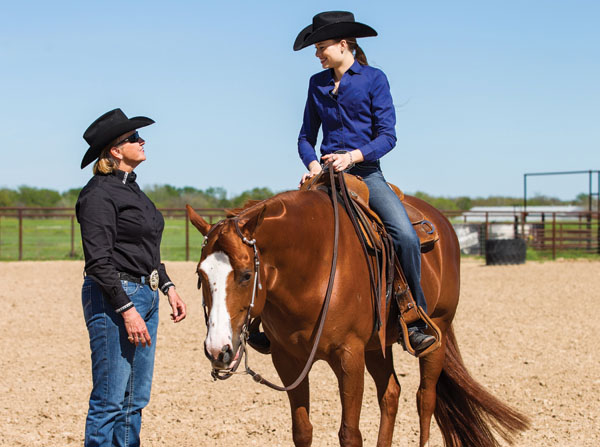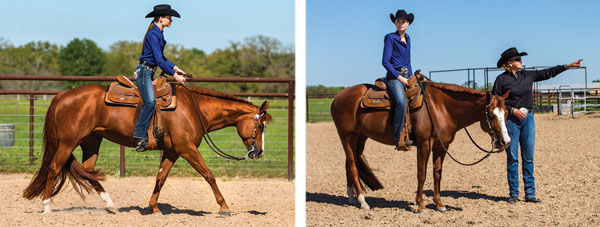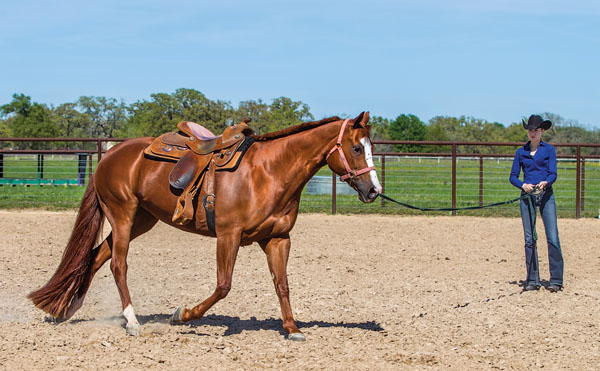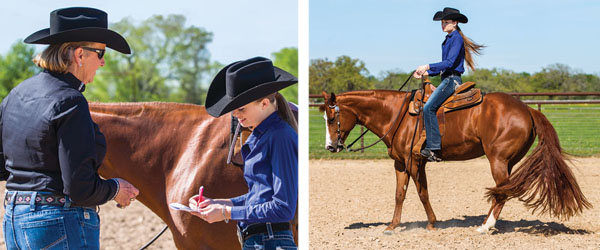Let’s say you’re among the many riders who train their own horses instead of keeping them in full-time training with a pro. And let’s also presume that you take lessons when you can.

Smart move. You know your horse—the good and bad—and lessons can help put you on the straight and narrow. We all tend to get into a rut when we ride by ourselves, and it can be hard to get out of once you’ve let it become established. But if someone suggests a change to you and it makes sense, you can be off and running again.
I have riders like you as students. Here’s some advice I give them to help make the most of our time training together. It’s advice that’ll help you, too.
Be Ready to Learn
1. Make sure you and your horse are fit. If your horse isn’t physically fit, he’s not going to be able to make it through an hour-long lesson without needing to stop and air up frequently. You won’t be able to maximize your time with your trainer if your horse isn’t up to the task. He’s only going to have so much energy, especially if it’s the summertime.
However, you don’t have to lope all the time to understand a technique. If your fitness levels are still building, you can do work at a walk and a trot that will benefit you. But it’s nice when the horse is fit enough for you to ride for an hour.
It helps if you’ve got enough physical strength to perform the actions required in day-to-day riding, too. Not all of us are strong enough in the core area, and it really takes a strong core to be a great rider. You can do things at home to strengthen your body that will have enormous benefit in your riding. Even if it’s just walking for endurance or climbing stairs for strength and wind, outside activities can help make you physically strong enough to work properly with your 1,200-pound horse. Riding is an athletic sport. You can’t be weak and expect to succeed.
2. Leave your distractions at home. For many people, horses are stress relief. If you can leave your stress at work, and really focus on what you’re doing, that helps you be present during your lesson. Everybody has another life. Just try to bring your brain when you get to the trainer’s barn. I understand, sometimes it’s not there—and sometimes your horse’s brain isn’t there, either. But do your best to focus on the task at hand. If you’re feeling really tired, angry, or upset, it might be best to reschedule your lesson for another time.
I tell all my students to leave their cell phones in their trucks. It’s just distracting to keep it with you. I’m just as bad as the next person; it’s so inviting to check your phone every now and then. But we’re only talking about an hour to an hour and a half without it. You’ll live. So park your cell phone somewhere else besides your body. That will prevent another common distraction: that of having to stop and hunt for a lost or dropped phone.
Train your mind to stay on-attention; don’t let it wander. I know it’s really hard, especially if you’re having a crisis in another area of your life. If you can, snap yourself back into the here and now. I even have to do that to myself sometimes, because my mind can go off track easily.
3. Communicate with your trainer. If this is your first lesson with a new trainer, you need to be specific about where you think your problems are, what you’d like to work on, and what your goals are. Whether you want to compete or just want to ride better on the trail, up-front communication helps the horse become a better horse and you become a better rider.

If you’re a repeat client, your trainer might already know where your problems are. But it’s still good to talk about these things before you ride, so your trainer can watch you ride and see how your horse responds. Then you can both discuss where your problems are, and begin the process of breaking them down into manageable training steps toward a solution. For instance, you might think your horse keeps taking the wrong lead, but your trainer may see that the horse isn’t in the proper position to pick up that lead, and give you means to fix that first.
4. Evaluate your horse’s energy level. If your horse is really fresh, I’d recommend longeing him or turning him out in a round pen before your lesson. Get there 15 minutes early, and take the extra time to work out that energy. If he’s fresh, nobody gets anything done, including your trainer. Five minutes of play would be better than getting mad when your horse isn’t able to focus.
Use Time Wisely
5. Take notes. Doing homework after your lesson helps. A lot of my clients write things down as we go during the lesson. Some wait until they’ve unsaddled to write down the things we discussed. Your trainer will fill your head with a lot of concepts and details during a lesson. You might remember the big chunks of information, but you can forget some of the little things that really matter. That’s why it makes a difference to get notes down quickly, before they slide from memory.
If your trainer clearly understands your goals, he or she should be able to give you feasible exercises or techniques to work on at home before your next lesson. This provides a way to measure whether something is working for you or not.
6. Give the principles you’ve learned a chance to take root. We live in a land of instant gratification. But horses don’t work that way. They’ll make you learn humility and patience pretty quickly. You can’t expect to transform your horse in five days. Although some horses show remarkable improvement in a week, it’s more likely that you’ll have to repeat things over and over with your horse. Eventually he’ll get it, and respond from memory, and then he won’t have to think about it anymore.
Approach your rides at home with a goal in mind. What principle from your lesson will you tackle today? How will you achieve that end? Your horse doesn’t know when training starts and when training ends, so make a point to be purposeful when you’re working on a new technique.
7. Watch others ride. Whether you’re at a show or at a lesson, use the time your horse is airing up to watch other riders. Good or bad, you can pick up things. You can see the things you don’t think you’ll ever do, and things that might help you.

Watch the warm-up pen at shows. See what people do to prepare. Again, you might like some of it, and you really won’t like other things. But you can bring ideas back to your next lesson, where you and your trainer can decide on what could work or be modified to work for you.
8. Get someone to watch you ride. Eyes on the ground, or even eyes from atop another horse, are so helpful. Even if it’s a friend or your mom, you can learn a lot about your riding by having someone observe you. If you can swallow your pride a little bit and listen to the observations, you’ll gain insight. If you don’t think they’re right, discuss without getting mad about it. If you don’t understand what they’re saying, tell them so they can explain it differently.
Some of the greatest eyes on the ground belong to mothers who don’t ride. But they listen, and they see. They watch. You might be surprised what Mom picks up and can see in your performance. (But that’s also why outside help such as that from a trainer can be helpful for your riding journey. It’s sometimes hard to listen to your mom as she evaluates your riding.)
Additional Tips
9. Interruptions don’t mean “stop riding.” Sometimes, a trainer gets interrupted during a lesson. That’s the reason some of my lessons can stretch into an hour and a half. But believe me, when I get interrupted, if I don’t have to leave the arena, I’m still watching you. I can see what you’re doing. It might take me a second to get back to you, but I will. Keep riding!

10. You’ve got to check your ego at the gate. When you’re trying to learn something, there’s no reason for you to not tell your trainer when you don’t understand something. If you don’t have a clue, don’t just sit there and listen without saying anything. Speak up and let your trainer know, so he or she can approach it from a different direction.
11. Be realistic about your goals. It’s helpful to be realistic about the horse you have, and what you can afford to do. See what you have. Look at the standard for the event where you want to excel. You can do anything you set your mind to, but are you fighting your horse’s natural level of talent? You might have a horse that has a great jog but only a so-so lope, or vice versa. He may not win at world-level Western pleasure, where the top horses are exceptional at all gaits. But that doesn’t mean you can’t compete at lower-level shows and do well with that horse.
Work to make your horse the best he can be, and become the best rider you can be. If you reach a crossroads between your horse’s ability and your goals, you’ll have to make a decision to possibly step up your horseflesh, if your skills are good enough for a higher-level horse. If you don’t have the money to progress any higher, learn to be happy with the horse you have. Often, you owe that first horse a huge debt of gratitude for teaching you, and for letting you do all the wrong things at the wrong times without killing you for doing it. That could be the best horse you’ll ever have. He’ll teach you an enormous amount of do’s and don’ts.
Nancy Cahill, Madisonville, Texas, is an AQHA Professional Horseman with more than 47 years’ experience guiding youth and amateur riders in all-around competition. She ‘s won several AQHA world championship titles, and her clients have competed successfully at the state and national level.






